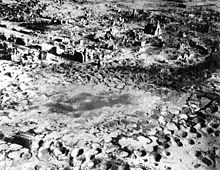Area Bombing Directive


The Area Bombing Directive (General Directive No. 5 (S.46368 / DCAS); "Instructions for area bombing ") was issued during the Second World War on February 14, 1942 by the British Department of Aviation .
In this instruction the new commander in chief of the Bomber Command of the Royal Air Force (RAF), Arthur Harris , was informed that he could use his armed forces immediately without any restrictions: “ You are accordingly authorized to use your forces without restriction […] ”. In addition, Harris was informed that the operations should be focused on the morale of the enemy civil population - especially those of the industrial workers: “ It has been decided that the primary objective of your operations should be focused on the morale of the enemy civil population and in particular the industrial workers ”.
A day after the instruction was announced, RAF Chief of Staff Air Marshal Charles Portal became even more explicit; he wrote: “ […] I suppose it is clear that the aiming points will be the built up areas, and not, for instance, the dockyards or aircraft factories where these are mentioned in Appendix A. This must be made quite clear if it is not already understood. "(German:" I assume that it is clear that the targets will be built-up areas and not, for example, shipyards or aircraft factories according to Appendix A. This must be made clear to everyone if it has not yet been understood in this way. ")
The implementation began with the night raid on Essen on March 8 and 9, 1942, as well as further air raids on the Ruhr area . Appendix A named fourteen other industrial cities in northern, central and southern Germany. Portal informed the Chiefs of Staff of the Army and the Navy on November 3, 1942 that the bomber weapon should be brought to 6,000 aircraft by the end of 1944. He put the monthly bomb rate for August 1944 at 90,000 tons.
The aim was to destroy eight million houses and 60 million apartments. He reckoned with 900,000 dead and a million seriously injured.
This strategy of area bombing was based on the assumption from the so-called Trenchard Doctrine that bombing residential areas instead of military installations would weaken the civilian population's willingness to fight . The concept was based on ideas about strategic aerial warfare from WWI . It was hoped to unleash uprisings or revolution against the government system in an opposing state in order to be able to derive a war-important advantage from destabilizing the enemy. However, this assumption turned out to be a fallacy. Today it is generally assumed that this strategy leads to exactly the opposite result, namely a solidarity of the population with a system of government towards the attacker.
Criticism and International Legal Norms
The question of whether it is legitimate to bomb civilians in war has long been controversial on several levels. In the United Kingdom, for example, the Anglican Bishop George Kennedy Allen Bell , a member of the House of Lords , publicly opposed the type of warfare by Churchill on several occasions and called area bombing "barbaric". The answer was outraged protests from politicians and private individuals.
The international legal question of whether the Area Bombing Directive is an instruction to commit serious war crimes is sparked in particular by the different interpretation of Article 25 of the Hague Land Warfare Code, which was then applicable :
"It is forbidden to attack or shoot at undefended cities, villages, dwellings or buildings, by whatever means."
In addition, a non-specific arrangement such as the Area Bombing Directive contradicts Article 27 of the Hague Land Warfare Regulations, which requires the protection of appropriately marked and not militarily defended cultural assets , “around the buildings dedicated to worship, art, science and charity to spare the historical monuments, the hospitals and assembly points for the sick and wounded as much as possible ”.
With the new regulation in the Geneva Convention of 1949 and specifically through Article 51 of Additional Protocol I of 1977, such area bombings are generally considered war crimes .